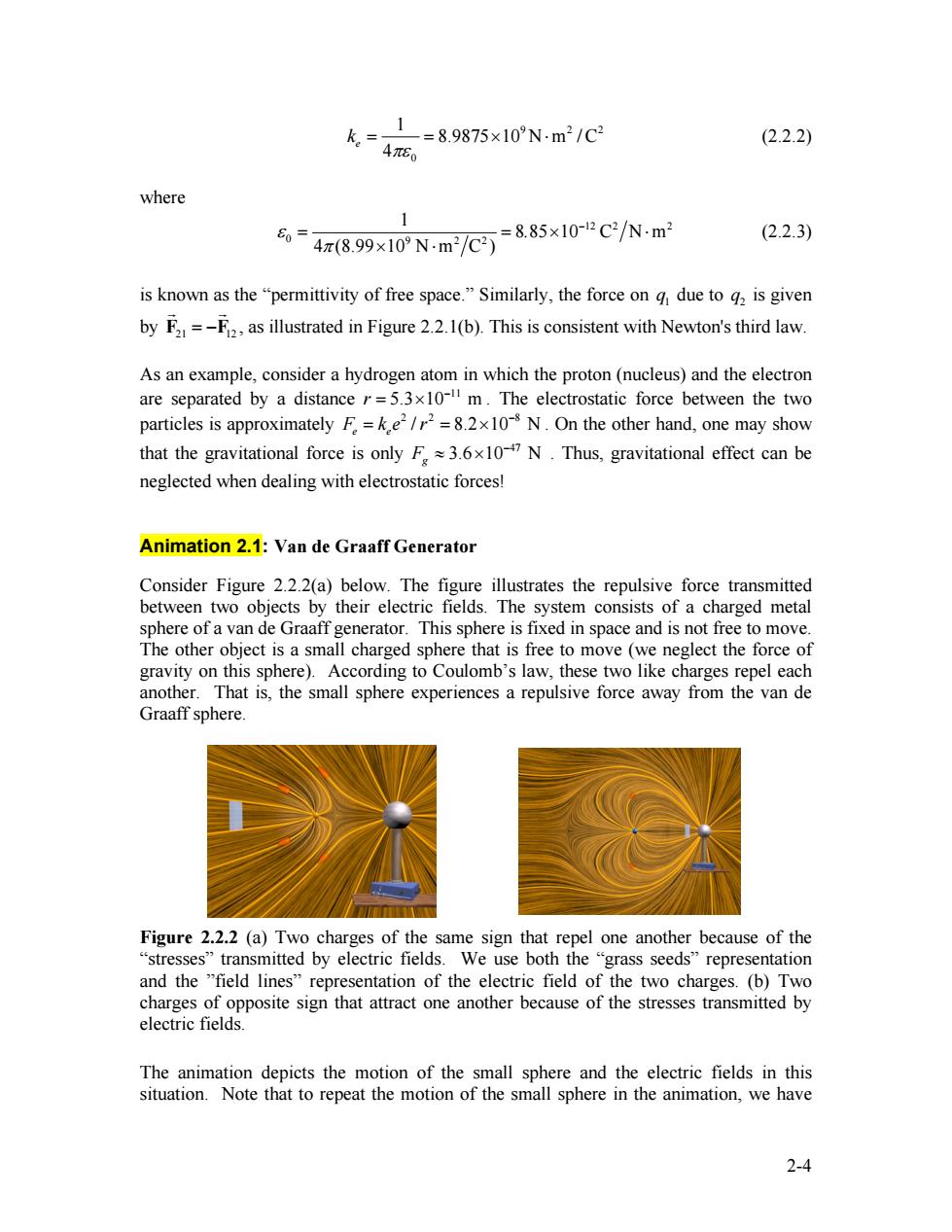正在加载图片...

1=89875×10N.m21C k。二4π (2.2.2) where 8=4899x10N-m/C-8.85x10-CN-m (2.2.3) is known as the "permittivity of free space."Similarly,the force on g due to g2 is given by F=-F2,as illustrated in Figure 2.2.1(b).This is consistent with Newton's third law. As an example,consider a hydrogen atom in which the proton (nucleus)and the electron are separated by a distance r=5.3x10-m.The electrostatic force between the two particles is approximately F=ke2/r2=8.2x10N.On the other hand,one may show that the gravitational force is only F3.6x10-47N.Thus,gravitational effect can be neglected when dealing with electrostatic forces! Animation 2.1:Van de Graaff Generator Consider Figure 2.2.2(a)below.The figure illustrates the repulsive force transmitted between two objects by their electric fields.The system consists of a charged metal sphere of a van de Graaff generator.This sphere is fixed in space and is not free to move. The other object is a small charged sphere that is free to move(we neglect the force of gravity on this sphere).According to Coulomb's law,these two like charges repel each another.That is,the small sphere experiences a repulsive force away from the van de Graaff sphere. 市m3本 Figure 2.2.2 (a)Two charges of the same sign that repel one another because of the “stresses'”transmitted by electric fields.We use both the“grass seeds”representation and the "field lines"representation of the electric field of the two charges.(b)Two charges of opposite sign that attract one another because of the stresses transmitted by electric fields. The animation depicts the motion of the small sphere and the electric fields in this situation.Note that to repeat the motion of the small sphere in the animation,we have 2-49 2 0 1 8.9875 10 N m /C 4 e k πε = = × ⋅ 2 (2.2.2) where 12 2 2 0 9 2 2 1 8 85 10 C N m 4 (8.99 10 N m C ) ε . π − = = × × ⋅ ⋅ (2.2.3) is known as the “permittivity of free space.” Similarly, the force on due to is given by , as illustrated in Figure 2.2.1(b). This is consistent with Newton's third law. 1 q 2 q F21 = −F12 G G As an example, consider a hydrogen atom in which the proton (nucleus) and the electron are separated by a distance . The electrostatic force between the two particles is approximately . On the other hand, one may show that the gravitational force is only . Thus, gravitational effect can be neglected when dealing with electrostatic forces! 11 r 5.3 10 m − = × 2 2 8 F k e ee /r 8.2 10 N − = = × 47 F g 3.6 10 N − ≈ × Animation 2.1: Van de Graaff Generator Consider Figure 2.2.2(a) below. The figure illustrates the repulsive force transmitted between two objects by their electric fields. The system consists of a charged metal sphere of a van de Graaff generator. This sphere is fixed in space and is not free to move. The other object is a small charged sphere that is free to move (we neglect the force of gravity on this sphere). According to Coulomb’s law, these two like charges repel each another. That is, the small sphere experiences a repulsive force away from the van de Graaff sphere. Figure 2.2.2 (a) Two charges of the same sign that repel one another because of the “stresses” transmitted by electric fields. We use both the “grass seeds” representation and the ”field lines” representation of the electric field of the two charges. (b) Two charges of opposite sign that attract one another because of the stresses transmitted by electric fields. The animation depicts the motion of the small sphere and the electric fields in this situation. Note that to repeat the motion of the small sphere in the animation, we have 2-4